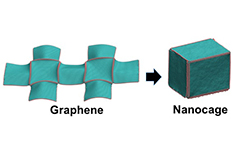Press Release
Tiny Origami Boxes Hold Big Promise for Hydrogen Energy Storage
Graphene folds itself into programmable "nanocage" for hydrogen storage, beating DOE 2020 goal
FOR IMMEDIATE RELEASE March 11, 2014
CONTACT:
Martha Heil
301 405 0876
mjheil@umd.edu

A sheet of carbon atoms folds by applying water along the red lines, then can be used to store hydrogen atoms, say mechanical engineers at the University of Maryland.
COLLEGE PARK--Just when you thought your origami skills couldn’t be beat – try using the world’s thinnest material, making the origami fold and unfold itself, and packing more inside than anyone expected. Researchers from the University of Maryland have done just that.
Graphene is the world’s thinnest material, just one atom thick. Mechanical engineers Shuze Zhu and Teng Li have found that they can make tiny squares of graphene fold into a box, which will open and close itself in response to an electric charge.
Inside the box, they’ve tucked hydrogen atoms, and have done so more efficiently than was thought possible. The U.S. Department of Energy is searching for ways to make storing energy with hydrogen a practical possibility, and they set up some goals: by 2017, the Department had hoped that a research team could pack in 5.5 percent hydrogen by weight, and that by 2020, it could be stretched to 7.5 percent.
Li’s team has already crossed that threshold, with a hydrogen storage density of 9.5 percent hydrogen by weight. The team has also demonstrated the potential to reach an even higher density, a future research goal.
“Just like paper origami that can make complicated 3-D structures from 2-D paper, graphene origami allows us to design and fabricate carbon nanostructures that are not naturally existing but of desirable properties,” said Li. “We have made nano-baskets, as well as these new nano-cages to hold hydrogen and other molecular cargos.”
The U.S. National Science Foundation supported the team’s research, which will be published in the journal ACS Nano.
Hydrogenation-Assisted Graphene Origami and Its Application in Programmable Molecular Mass Uptake, Storage, and Release
Shuze Zhu and Teng Li
ACS Nano, Article ASAP
DOI: 10.1021/nn500025t
Publication Date (Web): February 24, 2014
About the A. James Clark School of Engineering
The University of Maryland’s A. James Clark School of Engineering is a premier program, ranked among the top 20 in the world. Located just a few miles from Washington, D.C., the Clark School is at the center of a constellation of high-tech companies and federal laboratories, offering students and faculty access to unique professional opportunities.
Our broad spectrum of academic programs, including the world’s only accredited undergraduate fire protection engineering program, is complemented by a vibrant entrepreneurial ecosystem, early hands-on educational experiences, and participation in national and international competitions.
The Clark School is leading research advancements in aerospace, bioengineering, robotics, nanotechnology, disaster resilience, energy and sustainability, and cybersecurity. From the universal product code to satellite radio, SMS text messaging to the implantable insulin pump, our students, faculty, and alumni are engineering life-changing innovations for millions. Learn more at www.eng.umd.edu.